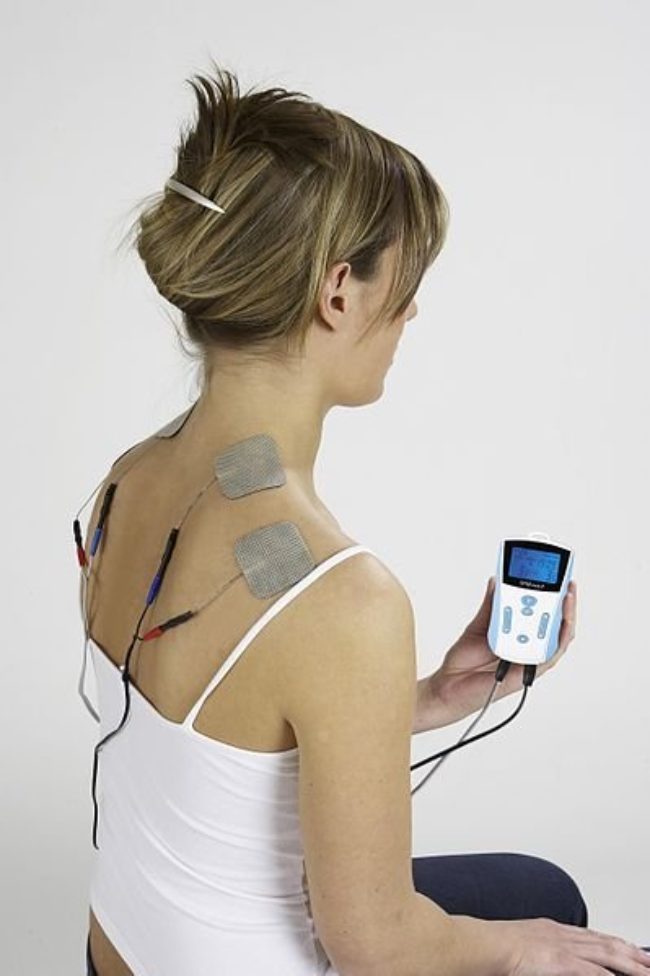What is TENS?
TENS is the most common and accessible form of hyperstimulation analgesia.
It is a non-invasive, non-addictive technique useful in both acute and chronic pain and in both pathophysiological (abnormal changes in the body due to a disease) and neuropathic pain (nerve pain).
It can be used for peripheral nerve disorders, phantom limb pain, spinal cord and spinal root lesions, low back pain, period pain, and muscle and joint pain.
While TENS does not cure the underlying cause of the pain, it can be very effective in relieving pain and, unlike pain medication, it does not cause nausea, drowsiness, personality changes, dependence, or limit daily activities.
It can help to decrease the reliance on oral analgesics.

How does TENS work?
- It stimulates nerve fibres, diminishing transmission of the fibres that produce pain.
- This means that the electrical current blocks the pain signal to the brain.
- Another theory is that the electrical activity may cause the body to release its own pain analgesics; these are called beta-endorphins, which is in line with the gate theory.
- The machine runs on a 9-volt battery so there is no risk at any time of electrocution.
Where is TENS administered?
You can use the TENS Machine by yourself at home after you’ve received instructions from our clinical staff on how to use the machine safely and been given written information on it.

Using a TENS Machine
- Ensure the TENS machine is turned off at the dials before applying or removing the electrodes.
- Place the pads on, and connect them to the machine. If your pain is low back pain, you may require some assistance in getting the pads in the correct position.
- Turn the on/off dial on slowly until you begin to feel a tingling sensation.
- It is recommended that you start slowly, beginning at an hour per day, increasing use up to 6 hours per day as the need arises.
- Once you feel a steady tingling sensation, experiment with the settings until you find what is comfortable for you.
- You may find that one setting works best while you are active, and another setting is best for when you are going to sleep.
Using the Electrodes
- The skin must be clean, dry and free from lotion or hair.
- Always lift the electrodes from the edge, not the lead wire.
- Always replace the electrodes to the “on” side of the storage liner.
- Always store and seal the electrodes in the original package in a cool, dry place.
- Never submerge electrodes or get them wet.
- Rehydrate the gel with a drop of water.
- Using heat or cold packs for long periods of time can cause adhesive separation.
- Electrodes are for single patient use only. Do not share your electrodes.
Contraindications
Do not use a TENS machine if you:
- Have a pacemaker.
- Have a heart problem or a history of cardiac disease.
- Are pregnant. There are no studies that either support or deny use of a TENS machine during pregnancy.
Key points to remember:
- It is important the TENS machine is not used for new pain. If you experience new pain, it is imperative that you are assessed first, before using the TENS machine to mitigate it.
- The TENS pads must NEVER be placed on your face, over your eyes, or over your carotid arteries (which are located on the front of your neck). The settings can be changed to suit your personal requirements.
- It is important to experiment with the settings to find what best suits your needs. What suits someone else may not suit you.
- Do not use the TENS while you are driving, or operating machinery. If you find that this is a necessary part of your work, do not change the position of the controls while you are working.
If you require further information or are unsure at any time how to use your TENS machine, please contact the Nurses at the Hunter Pain Specialists on (02) 4985 1800.